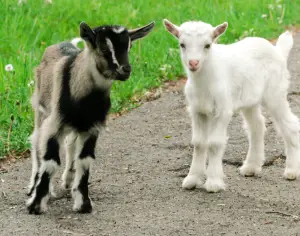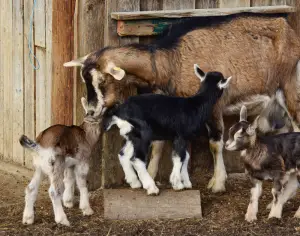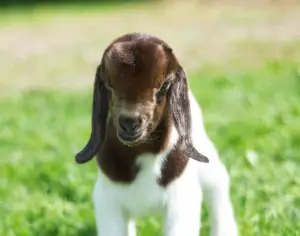What Baby Goats Are Called
Goats are great to have around on both small homesteads and large farms. If you’re thinking about getting some goats, you might be wondering what a baby goat is called. Just like other farm animals, goats come with their own special jargon for males, females, and babies.
So, what is a baby goat called? A newborn baby goat is called a kid. Kids are goats that are under a year old. A group of kids is referred to as a herd or tribe of kids. The word “lamb” only refers to baby sheep and is not used for baby goats.
Goats also come with a unique set of unusual anatomy and physical and mental abilities. If you’d like to know why goats don’t technically graze like other farm animals and why their pupils are shaped like rectangles, read on!
Facts About Baby Goats
Baby Goats Are Quick Learners 
Baby goats are able to stand and take their first steps within about 10 minutes of being born. This is notably faster than calves and foals, which take about 30 minutes or so to successfully stand and take steps. This is a behavior they need to be able to do quickly in order to begin nursing and ingest colostrum.
Colostrum is the first of the milk from the doe. It contains extra nutrients to help with the baby’s health and immune system and is only produced for the first couple of days. Failing to ingest milk quickly will result in weakness, which may result in further difficulty nursing and ultimately in starvation.
And if one kid goat is taken away from the mother perhaps for medical reasons immediately after birth and another kid is present, it is possible that the second kid will consume all of the colostrum before the first was able to ingest any. The chance of a baby goat surviving without colostrum is pretty low, so it’s best to ensure that all newborns get access as soon as possible.
For special circumstances, there are commercial colostrum replacers that can be given in place of the mother’s colostrum. But natural colostrum is always preferable.
Baby Goats Have Unique Eyes
You’ve probably noticed the strange, rectangular-shaped pupils that stare creepily out at you from goat eyes. Their pupils are shaped this way to provide them with a broader view of their surroundings so they can keep watch for predators. Sheep also have rectangular pupils, as do octopuses and toads.
Why Kid Goats Bleat
Baby goats are born professional bleaters. They arrive on this earth with an impressive set of lungs and they use them to their fullest extent. Baby goats may cry due to being hungry, lonely, too hot, too cold, injured, bored, or as a reaction to tension within the herd. They can tell when something is wrong around them and they love to share their feelings on the matter.
Goat Distinctions
Goats are similar to deer, and so one set of names for adult goats is “doe” for females and “buck” for males. But both sexes have additional names besides these.
Adult Female Goats 
For up to the first year of life, a female goat may be called a “doeling.” Female goats reach reproductive maturity at 4-12 months of age. Once they are mature adults, they can either be called a doe or a nanny (since they take care of the kids). These names are used interchangeably and there is no discernible difference between the two.
When a doe goat gives birth, the process is referred to as “kidding.” Does usually give birth to one or two babies, with the occasional set of triplets making an appearance. It’s very important to ensure that a doe has plenty of access to nutritious food before, during, and after kidding, as a lack of nutrients can affect her ability to get pregnant, safely give birth to healthy kids, and produce sufficient milk.
Proper nutrition is also needed in order to produce colostrum, a special kind of milk that is produced during the first couple of days after giving birth. More on this below.
Adult Male Goats
Similarly to female goats, young male goats are referred to as “bucklings” until they reach reproductive maturity or one year of age. Male goats also reach maturity between 4 and 12 months of age, depending on the breed, time of year, and available nutrients. The terms “buck” and “billy” can be used interchangeably.
Male goats are the most influential part of the herd genetically speaking, because they can breed with multiple females every month. The number of females they can successfully impregnate increases over time, so ensuring that you’ve invested in an excellent genetic specimen to breed with your females is very important.
Bucks over 1 year of age can usually breed with about 10 females per month. At 2 years of age, bucks can handle around 25 females per month. From age 3 onword, 40 females can be bred to the male per month. This is why it is so important to invest in a quality buck, since his genes will have the opportunity to affect an awful lot of kids.
Fun Facts about Adult Goats
Goat Meat Consumption
While many sources claim that goat meat is the most consumed per capita worldwide, this is not actually supported by facts. According to a survey performed in 2018 by an investment company, goat meat is actually number six on the list. According to this survey, 13 million tons of goat meat are consumed every year worldwide. Two more million tons of sheep meat are consumed every year, with pork weighing in on the number one spot at 121 million tons.
The Extent of Goat Intelligence
Goats are a lot more intelligent than we give them credit for. They are capable of learning their names and coming when called. They are also one of the few species capable of understanding the human gestures of pointing or gazing. While most animals don’t comprehend the action of indicating an object by pointing a finger or pointedly looking at it, goats have been shown to understand this human communication method.
Because of their intelligence and their well-developed abilities to climb most surfaces and forage for food in even the most unforgiving environments, goats can get bored in captivity. With food so readily available and enclosures that are often bland and too open, goats frequently miss out on the kind of mental stimulation they really need. This can be remedied with toys, foraging containers, climbing structures, and enlarging of the available roaming and climbing space when possible.
They also have strong social needs. Goats are extroverts. They need their friends around 100% of the time. Without constant social interaction, a single goat will become lonely and may become languid or develop undesirable behaviors.
How Much Goats Climb
Goats can climb anything. From fences to houses and everything in between, goats will find a way. They’ll even climb onto each other and other animals. And somehow, miraculously, they almost never lose their footing.
How Goats Eat
Goats are actually classified as browsers rather than grazers. Where animals like horses and cows graze, which means they eat mostly grass and very low-to-the-ground vegetation, browsers tend to eat vegetation that grows a little higher from the ground. Bark from trees, leaves, and shrubs are all examples of things that goats tend to prefer.
Additionally, animals who graze have smaller mouths and stiffer lips for ripping up grass, while browsers have wider mouths and longer tongues for reaching up and grabbing plants that are higher-up.
Congratulations! You now know what to call your male, female, and baby goats and are armed with all the random fun facts about goats. Have fun caring for your does, bucks, and kids!
Caring for Baby Goats
If you plan on getting a baby goat soon, you’ll want to ensure that you know how to properly care for them. You can check out my list of what you’ll need in order to care for goats here.
P.S. Save this article to your “Goat” board on Pinterest!

